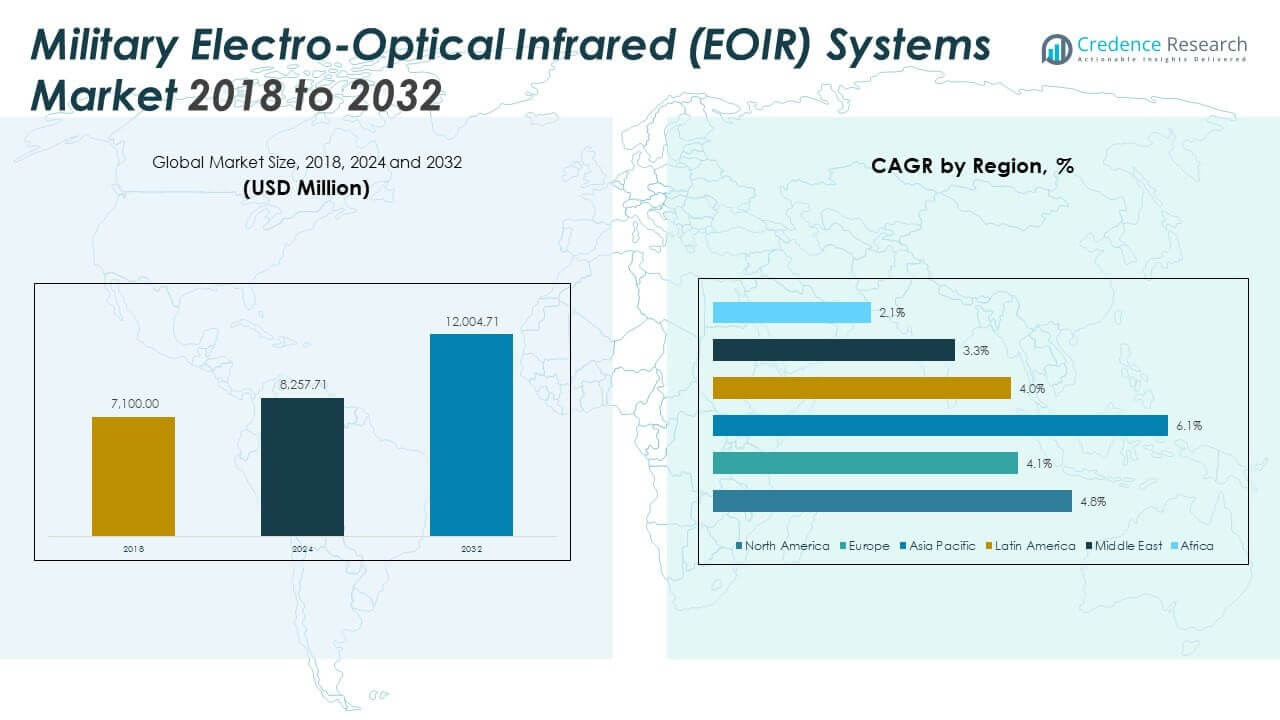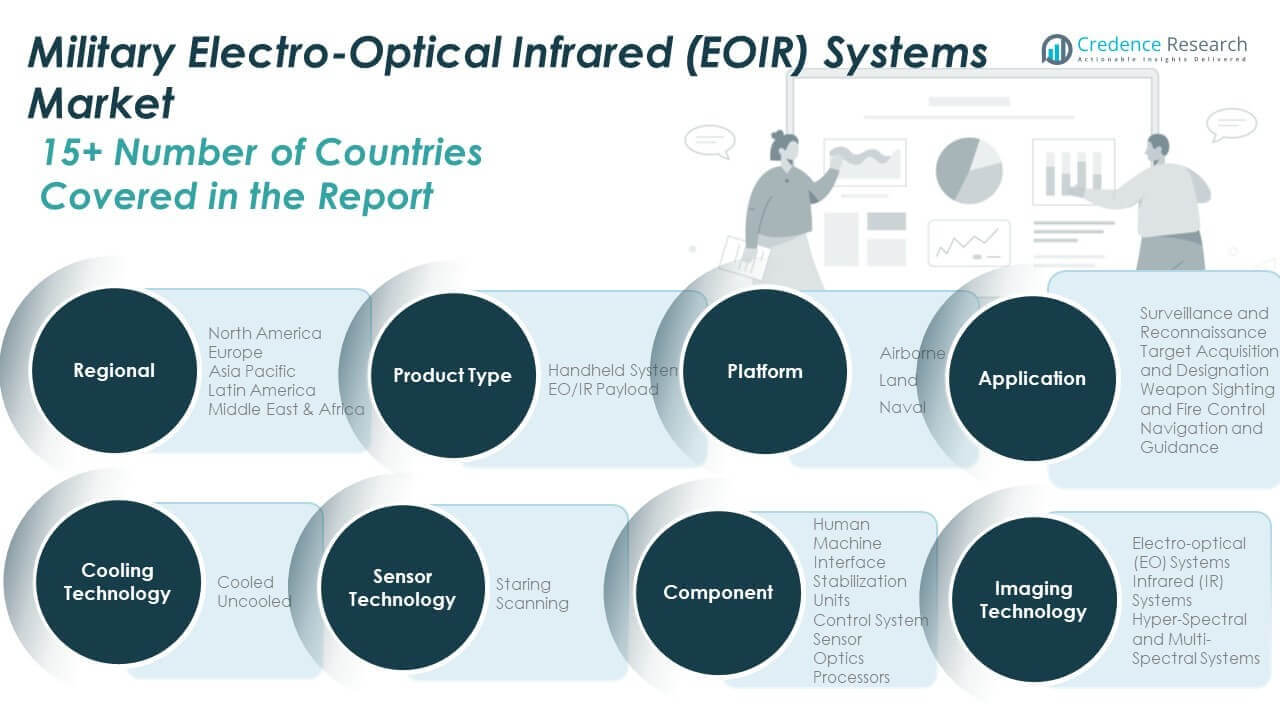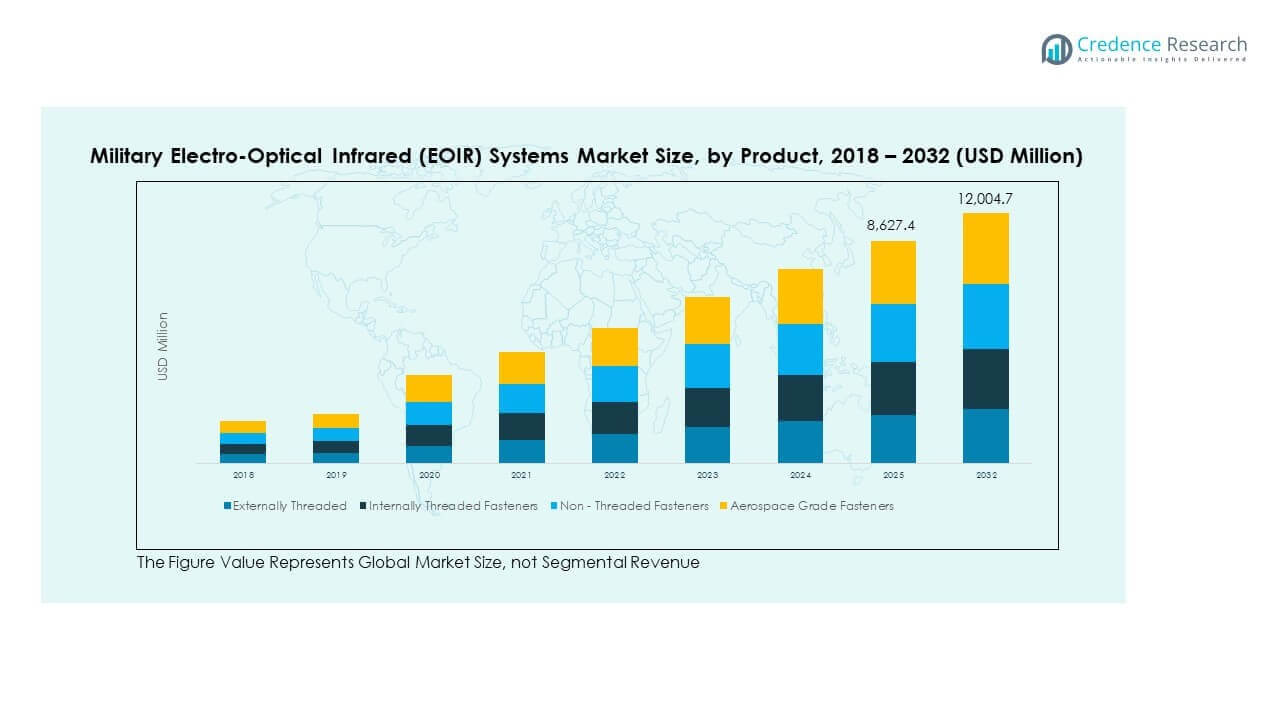CHAPTER NO. 1 : GENESIS OF THE MARKET
1.1 Market Prelude – Introduction & Scope
1.2 The Big Picture – Objectives & Vision
1.3 Strategic Edge – Unique Value Proposition
1.4 Stakeholder Compass – Key Beneficiaries
CHAPTER NO. 2 : EXECUTIVE LENS
2.1 Pulse of the Industry – Market Snapshot
2.2 Growth Arc – Revenue Projections (USD Million)
2.3. Premium Insights – Based on Primary Interviews
CHAPTER NO. 3 : MILITARY ELECTRO-OPTICAL INFRARED (EOIR) SYSTEMS MARKET FORCES & INDUSTRY PULSE
3.1 Foundations of Change – Market Overview
3.2 Catalysts of Expansion – Key Market Drivers
3.2.1 Momentum Boosters – Growth Triggers
3.2.2 Innovation Fuel – Disruptive Technologies
3.3 Headwinds & Crosswinds – Market Restraints
3.3.1 Regulatory Tides – Compliance Challenges
3.3.2 Economic Frictions – Inflationary Pressures
3.4 Untapped Horizons – Growth Potential & Opportunities
3.5 Strategic Navigation – Industry Frameworks
3.5.1 Market Equilibrium – Porter’s Five Forces
3.5.2 Ecosystem Dynamics – Value Chain Analysis
3.5.3 Macro Forces – PESTEL Breakdown
3.6 Price Trend Analysis
3.6.1 Regional Price Trend
3.6.2 Price Trend by product
CHAPTER NO. 4 : KEY INVESTMENT EPICENTER
4.1 Regional Goldmines – High-Growth Geographies
4.2 Product Frontiers – Lucrative Product Categories
4.3 Product Sweet Spots – Emerging Demand Segments
CHAPTER NO. 5: REVENUE TRAJECTORY & WEALTH MAPPING
5.1 Momentum Metrics – Forecast & Growth Curves
5.2 Regional Revenue Footprint – Market Share Insights
5.3 Segmental Wealth Flow – Product Type & Product Revenue
CHAPTER NO. 6 : TRADE & COMMERCE ANALYSIS
6.1. Import Analysis by Region
6.1.1. Global Military Electro-Optical Infrared (EOIR) Systems Market Import Revenue By Region
6.2. Export Analysis by Region
6.2.1. Global Military Electro-Optical Infrared (EOIR) Systems Market Export Revenue By Region
CHAPTER NO. 7 : COMPETITION ANALYSIS
7.1. Company Market Share Analysis
7.1.1. Global Military Electro-Optical Infrared (EOIR) Systems Market: Company Market Share
7.2. Global Military Electro-Optical Infrared (EOIR) Systems Market Company Revenue Market Share
7.3. Strategic Developments
7.3.1. Acquisitions & Mergers
7.3.2. New Product Launch
7.3.3. Regional Expansion
7.4. Competitive Dashboard
7.5. Company Assessment Metrics, 2024
CHAPTER NO. 8 : MILITARY ELECTRO-OPTICAL INFRARED (EOIR) SYSTEMS MARKET – BY PRODUCT TYPE SEGMENT ANALYSIS
8.1. Military Electro-Optical Infrared (EOIR) Systems Market Overview by Product Type Segment
8.1.1. Military Electro-Optical Infrared (EOIR) Systems Market Revenue Share By Product Type
8.2. Handheld System
8.3. EO/IR Payload
CHAPTER NO. 9 : MILITARY ELECTRO-OPTICAL INFRARED (EOIR) SYSTEMS MARKET – BY PLATFORM SEGMENT ANALYSIS
9.1. Military Electro-Optical Infrared (EOIR) Systems Market Overview by Platform Segment
9.1.1. Military Electro-Optical Infrared (EOIR) Systems Market Revenue Share By Platform
9.2. Airborne
9.3. Land
9.4. Naval
CHAPTER NO. 10 : MILITARY ELECTRO-OPTICAL INFRARED (EOIR) SYSTEMS MARKET – BY IMAGING TECHNOLOGY SEGMENT ANALYSIS
10.1. Military Electro-Optical Infrared (EOIR) Systems Market Overview by Imaging Technology Segment
10.1.1. Military Electro-Optical Infrared (EOIR) Systems Market Revenue Share By Imaging Technology
10.2. Electro-optical (EO) Systems
10.3. Infrared (IR) Systems
10.4. Hyper-Spectral and Multi-Spectral Systems
CHAPTER NO. 11 : MILITARY ELECTRO-OPTICAL INFRARED (EOIR) SYSTEMS MARKET – BY APPLICATION SEGMENT ANALYSIS
11.1. Military Electro-Optical Infrared (EOIR) Systems Market Overview by Application Segment
11.1.1. Military Electro-Optical Infrared (EOIR) Systems Market Revenue Share By Application
11.2. Surveillance and Reconnaissance
11.3. Target Acquisition and Designation
11.4. Weapon Sighting and Fire Control
11.5. Navigation and Guidance
CHAPTER NO. 12 : MILITARY ELECTRO-OPTICAL INFRARED (EOIR) SYSTEMS MARKET – BY COOLING TECHNOLOGY SEGMENT ANALYSIS
12.1. Military Electro-Optical Infrared (EOIR) Systems Market Overview by Cooling Technology Segment
12.1.1. Military Electro-Optical Infrared (EOIR) Systems Market Revenue Share By Cooling Technology
12.2. Cooled
12.3. Uncooled
CHAPTER NO. 13 : MILITARY ELECTRO-OPTICAL INFRARED (EOIR) SYSTEMS MARKET – BY SENSOR TECHNOLOGY SEGMENT ANALYSIS
13.1. Military Electro-Optical Infrared (EOIR) Systems Market Overview by Sensor Technology Segment
13.1.1. Military Electro-Optical Infrared (EOIR) Systems Market Revenue Share By Sensor Technology
13.2. Staring
13.3. Scanning
CHAPTER NO. 14 : MILITARY ELECTRO-OPTICAL INFRARED (EOIR) SYSTEMS MARKET – BY COMPONENT SEGMENT ANALYSIS
14.1. Military Electro-Optical Infrared (EOIR) Systems Market Overview by Component
14.1.1. Military Electro-Optical Infrared (EOIR) Systems Market Revenue Share By Component
14.2. Human Machine Interface
14.3. Stabilization Units
14.4. Control System
14.5. Sensor
14.6. Optics
14.7. Processors
CHAPTER NO. 15 : MILITARY ELECTRO-OPTICAL INFRARED (EOIR) SYSTEMS MARKET – REGIONAL ANALYSIS
15.1. Military Electro-Optical Infrared (EOIR) Systems Market Overview by Region Segment
15.1.1. Global Military Electro-Optical Infrared (EOIR) Systems Market Revenue Share By Region
15.1.2. Regions
15.1.3. Global Military Electro-Optical Infrared (EOIR) Systems Market Revenue By Region
15.1.4. Product Type
15.1.5. Global Military Electro-Optical Infrared (EOIR) Systems Market Revenue By Product Type
15.1.6. Platform
15.1.7. Global Military Electro-Optical Infrared (EOIR) Systems Market Revenue By Platform
15.1.8. Imaging Technology
15.1.9. Global Military Electro-Optical Infrared (EOIR) Systems Market Revenue By Imaging Technology
15.1.10. Application
15.1.12. Global Military Electro-Optical Infrared (EOIR) Systems Market Revenue By Application
15.1.13. Sensor Technology
15.1.14. Global Military Electro-Optical Infrared (EOIR) Systems Market Revenue By Sensor Technology
15.1.15. Component
15.1.16. Global Military Electro-Optical Infrared (EOIR) Systems Market Revenue By Component
CHAPTER NO. 14 : NORTH AMERICA MILITARY ELECTRO-OPTICAL INFRARED (EOIR) SYSTEMS MARKET – COUNTRY ANALYSIS
14.1. North America Military Electro-Optical Infrared (EOIR) Systems Market Overview by Country Segment
14.1.1. North America Military Electro-Optical Infrared (EOIR) Systems Market Revenue Share By Region
14.2. North America
14.2.1. North America Military Electro-Optical Infrared (EOIR) Systems Market Revenue By Country
14.2.2. Product Type
14.2.3. North America Military Electro-Optical Infrared (EOIR) Systems Market Revenue By Product Type
14.2.4. Platform
14.2.5. North America Military Electro-Optical Infrared (EOIR) Systems Market Revenue By Platform
14.2.6. Imaging Technology
14.2.7. North America Military Electro-Optical Infrared (EOIR) Systems Market Revenue By Imaging Technology
14.2.8. Application
14.2.9. North America Military Electro-Optical Infrared (EOIR) Systems Market Revenue By Application
14.2.10. Cooling Technology
14.2.11. North America Military Electro-Optical Infrared (EOIR) Systems Market Revenue By Cooling Technology
14.2.12. Sensor Technology
14.2.13. North America Military Electro-Optical Infrared (EOIR) Systems Market Revenue By Sensor Technology
14.2.14. Component
14.2.15. North America Military Electro-Optical Infrared (EOIR) Systems Market Revenue By Component
14.3. U.S.
14.4. Canada
14.5. Mexico
CHAPTER NO. 15 : EUROPE MILITARY ELECTRO-OPTICAL INFRARED (EOIR) SYSTEMS MARKET – COUNTRY ANALYSIS
15.1. Europe Military Electro-Optical Infrared (EOIR) Systems Market Overview by Country Segment
15.1.1. Europe Military Electro-Optical Infrared (EOIR) Systems Market Revenue Share By Region
15.2. Europe
15.2.1. Europe Military Electro-Optical Infrared (EOIR) Systems Market Revenue By Country
15.2.2. Product Type
15.2.3. Europe Military Electro-Optical Infrared (EOIR) Systems Market Revenue By Product Type
15.2.4. Platform
15.2.5. Europe Military Electro-Optical Infrared (EOIR) Systems Market Revenue By Platform
15.2.6. Imaging Technology
15.2.7. Europe Military Electro-Optical Infrared (EOIR) Systems Market Revenue By Imaging Technology
15.2.8. Application
15.2.9. Europe Military Electro-Optical Infrared (EOIR) Systems Market Revenue By Application
15.2.10. Cooling Technology
15.2.11. Europe Military Electro-Optical Infrared (EOIR) Systems Market Revenue By Cooling Technology
15.2.12. Sensor Technology
15.2.13. Europe Military Electro-Optical Infrared (EOIR) Systems Market Revenue By Sensor Technology
15.2.14. Component
15.2.15. Europe Military Electro-Optical Infrared (EOIR) Systems Market Revenue By Component
15.3. UK
15.4. France
15.5. Germany
15.6. Italy
15.7. Spain
15.8. Russia
15.9. Rest of Europe
CHAPTER NO. 16 : ASIA PACIFIC MILITARY ELECTRO-OPTICAL INFRARED (EOIR) SYSTEMS MARKET – COUNTRY ANALYSIS
16.1. Asia Pacific Military Electro-Optical Infrared (EOIR) Systems Market Overview by Country Segment
16.1.1. Asia Pacific Military Electro-Optical Infrared (EOIR) Systems Market Revenue Share By Region
16.2. Asia Pacific
16.2.1. Asia Pacific Military Electro-Optical Infrared (EOIR) Systems Market Revenue By Country
16.2.2. Product Type
16.2.3. Asia Pacific Military Electro-Optical Infrared (EOIR) Systems Market Revenue By Product Type
16.2.4. Platform
16.2.5. Asia Pacific Military Electro-Optical Infrared (EOIR) Systems Market Revenue By Platform
16.2.6. Imaging Technology
16.2.7. Asia Pacific Military Electro-Optical Infrared (EOIR) Systems Market Revenue By Imaging Technology
16.2.8. Application
16.2.9. Asia Pacific Military Electro-Optical Infrared (EOIR) Systems Market Revenue By Application
16.2.10. Cooling Technology
16.2.11. Asia Pacific Military Electro-Optical Infrared (EOIR) Systems Market Revenue By Cooling Technology
16.2.12. Sensor Technology
16.2.13. Asia Pacific Military Electro-Optical Infrared (EOIR) Systems Market Revenue By Cooling Technology
16.2.14. Component
16.2.15. Asia Pacific Military Electro-Optical Infrared (EOIR) Systems Market Revenue By Component
16.3. China
16.4. Japan
16.5. South Korea
16.6. India
16.7. Australia
16.8. Southeast Asia
16.9. Rest of Asia Pacific
CHAPTER NO. 17 : LATIN AMERICA MILITARY ELECTRO-OPTICAL INFRARED (EOIR) SYSTEMS MARKET – COUNTRY ANALYSIS
17.1. Latin America Military Electro-Optical Infrared (EOIR) Systems Market Overview by Country Segment
17.1.1. Latin America Military Electro-Optical Infrared (EOIR) Systems Market Revenue Share By Region
17.2. Latin America
17.2.1. Latin America Military Electro-Optical Infrared (EOIR) Systems Market Revenue By Country
17.2.2. Product Type
17.2.3. Latin America Military Electro-Optical Infrared (EOIR) Systems Market Revenue By Product Type
17.2.4. Platform
17.2.5. Latin America Military Electro-Optical Infrared (EOIR) Systems Market Revenue By Platform
17.2.6. Imaging Technology
17.2.7. Latin America Military Electro-Optical Infrared (EOIR) Systems Market Revenue By Imaging Technology
17.2.8. Application
17.2.9. Latin America Military Electro-Optical Infrared (EOIR) Systems Market Revenue By Application
17.2.10. Cooling Technology
17.2.11. Latin America Military Electro-Optical Infrared (EOIR) Systems Market Revenue By Cooling Technology
17.2.12. Sensor Technology
17.2.13. Latin America Military Electro-Optical Infrared (EOIR) Systems Market Revenue By Sensor Technology
17.2.14. Component
17.2.15. Latin America Military Electro-Optical Infrared (EOIR) Systems Market Revenue By Component
17.3. Brazil
17.4. Argentina
17.5. Rest of Latin America
CHAPTER NO. 18 : MIDDLE EAST MILITARY ELECTRO-OPTICAL INFRARED (EOIR) SYSTEMS MARKET – COUNTRY ANALYSIS
18.1. Middle East Military Electro-Optical Infrared (EOIR) Systems Market Overview by Country Segment
18.1.1. Middle East Military Electro-Optical Infrared (EOIR) Systems Market Revenue Share By Region
18.2. Middle East
18.2.1. Middle East Military Electro-Optical Infrared (EOIR) Systems Market Revenue By Country
18.2.2. Product Type
18.2.3. Middle East Military Electro-Optical Infrared (EOIR) Systems Market Revenue By Product Type
18.2.4. Platform
18.2.5. Middle East Military Electro-Optical Infrared (EOIR) Systems Market Revenue By Platform
18.2.6. Imaging Technology
18.2.7. Middle East Military Electro-Optical Infrared (EOIR) Systems Market Revenue By Imaging Technology
18.2.8. Application
18.2.9. Middle East Military Electro-Optical Infrared (EOIR) Systems Market Revenue By Application
18.2.10. Cooling Technology
18.2.11. Middle East Military Electro-Optical Infrared (EOIR) Systems Market Revenue By Cooling Technology
18.2.12. Sensor Technology
18.2.13. Middle East Military Electro-Optical Infrared (EOIR) Systems Market Revenue By Sensor Technology
18.2.14. Component
18.2.15. Middle East Military Electro-Optical Infrared (EOIR) Systems Market Revenue By Component
18.3. GCC Countries
18.4. Israel
18.5. Turkey
18.6. Rest of Middle East
CHAPTER NO. 19 : AFRICA MILITARY ELECTRO-OPTICAL INFRARED (EOIR) SYSTEMS MARKET – COUNTRY ANALYSIS
19.1. Africa Military Electro-Optical Infrared (EOIR) Systems Market Overview by Country Segment
19.1.1. Africa Military Electro-Optical Infrared (EOIR) Systems Market Revenue Share By Region
19.2. Africa
19.2.1. Africa Military Electro-Optical Infrared (EOIR) Systems Market Revenue By Country
19.2.2. Product Type
19.2.3. Africa Military Electro-Optical Infrared (EOIR) Systems Market Revenue By Product Type
19.2.4. Platform
19.2.5. Africa Military Electro-Optical Infrared (EOIR) Systems Market Revenue By Platform
19.2.6. Imaging Technology
19.2.7. Africa Military Electro-Optical Infrared (EOIR) Systems Market Revenue By Imaging Technology
19.2.8. Application
19.2.9. Africa Military Electro-Optical Infrared (EOIR) Systems Market Revenue By Application
19.2.10. Cooling Technology
19.2.11. Africa Military Electro-Optical Infrared (EOIR) Systems Market Revenue By Cooling Technology
19.2.12. Sensor Technology
19.2.13. Africa Military Electro-Optical Infrared (EOIR) Systems Market Revenue By Sensor Technology
19.2.14. Component
19.2.15. Africa Military Electro-Optical Infrared (EOIR) Systems Market Revenue By Component
19.3. South Africa
19.4. Egypt
19.5. Rest of Africa
CHAPTER NO. 20 : COMPANY PROFILES
20.1. Lockheed Martin Corporation
20.1.1. Company Overview
20.1.2. Product Portfolio
20.1.3. Financial Overview
20.1.4. Recent Developments
20.1.5. Growth Strategy
20.1.6. SWOT Analysis
20.2. Northrop Grumman Corporation
20.3. Raytheon Technologies Corporation
20.4. Thales Group, Leonardo S.p.A.
20.5. L3Harris Technologies, Inc.
20.6. FLIR Systems, Inc.
20.7. BAE Systems Plc
20.8. Leonardo S.p.A.
20.9. Rheinmetall AG
20.10. Saab AB






